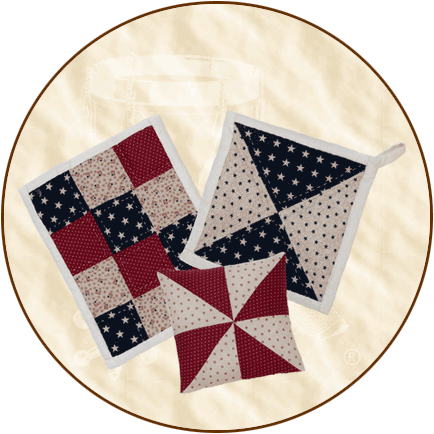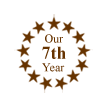.
Continued from product description
on Home Crafts' Page Two...
Historical
Background: The word "quilting" comes from the
Latin word "culcita," which means a "cushion"
or "stuffed mattress." There are two particular types
of quilting. One is called "wadding," or English quilting,
and the other type is called "cord," or Italian quilting.
English quilting is the type most people are familiar with. It
is the kind of quilting that describes two pieces of fabric on
the outside and one layer of cotton or wool batting on the inside.
The outside top piece is usually the "patchwork" piece
with a design and the underneath side is plain. Stitching is
done through all three layers and can be sewn intricately with
beautiful designs or can be as plain as diagonal rows across
the entire quilt. The sewing of the three layers together is
the part that is actually referred to as the quilting.
The other type, Italian quilting, normally only uses the two
pieces of fabric and no batting. The two pieces of fabric are
laid together and the stitching is done in narrow lines on either
side of a cord in a pattern such as a heart or some geometric
design. A variation of this type of quilting is known as "padded
quilting" or "trapunto quilting." This kind of
quilting was historically done on white linen and featured lovely
patterns of leaves, shells, circles, and other designs. Many
of the patterns used in trapunto quilting have been handed down
from generation to generation.
Early American quilts were made as useful items for the home
and were not thought of as beautiful works of art. Quilting was
merely done to keep the fabric and inside layer together to be
used as a warm blanket on bedding. Over time, women proceeded
to make quilting as beautiful as other needle crafts in the past.
Beautiful stitching in white thread upon a plain white material
has come to be regarded as one of the most beautiful types of
quilts.
Quilting was practiced in ancient Greece, Egypt, China, and
India as well as other places. Quilted fabric was used for clothing
as well as for beds. English and Dutch colonists influenced the
American quilt probably more than any other culture. Quilting
in America has never ceased.
A quilting frame (which is not to be confused with a loom)
can take up much space. An Early American woman would have the
quilt top finished, gather her friends and neighbors together
for a "quilting bee," and this piece of equipment would
be set up until the quilting was finished. Quilting bees were
a cherished event when women could get together, talk, and share
stories with one another.
Early American quilting required much labor, careful
piecing, and many complex stitches (which later quilters thought
too excruciating). Women from this time period, however, reveled
in the difficulties of patchwork quilting. They shared designs,
bits of calico, and discussions regarding quilting with much
more enthusiasm than in the late 1800s. Many women today still
enjoy the intricacies of detailed quilting. Others simply enjoy
the patchwork part and use a sewing machine to do the quilting.













